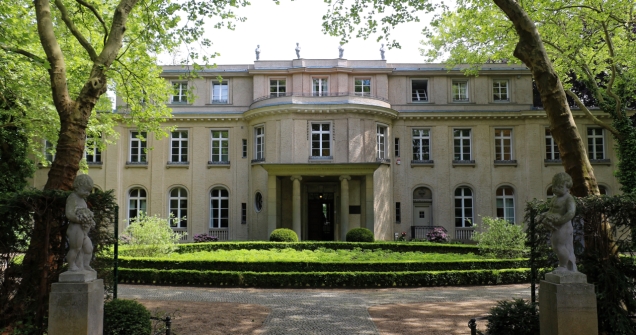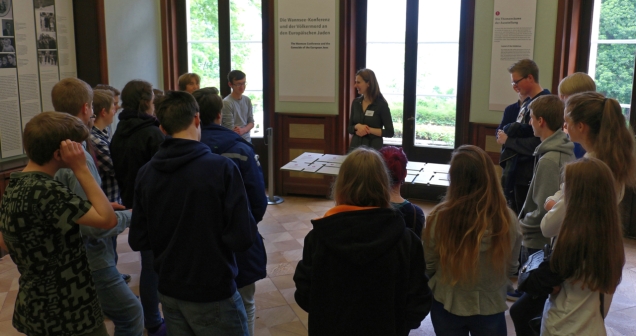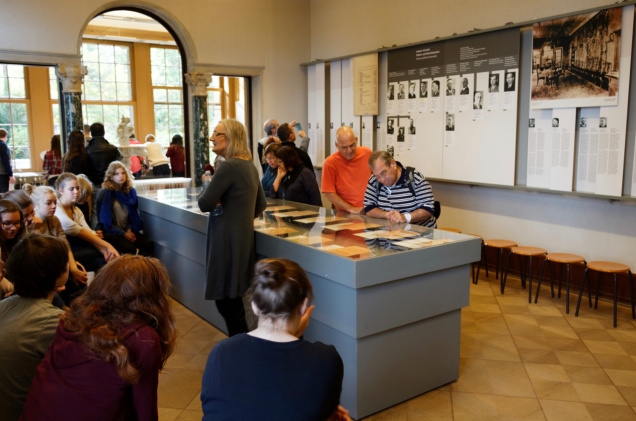 The House of the Wannsee Conference, a lakeside villa located roughly halfway between Central Berlin and Potsdam, is a place that is important and interesting for several reasons. First of all because it is the location where a group of senior Nazis and government officials on 20 January 1942 cemented the ‘Final Solution to the Jewish Question’ – the euphemism they used for the mass deportations of all European Jews to death camps in Eastern Europe.
The House of the Wannsee Conference, a lakeside villa located roughly halfway between Central Berlin and Potsdam, is a place that is important and interesting for several reasons. First of all because it is the location where a group of senior Nazis and government officials on 20 January 1942 cemented the ‘Final Solution to the Jewish Question’ – the euphemism they used for the mass deportations of all European Jews to death camps in Eastern Europe.
Secondly, the House of the Wannsee Conference Memorial and Educational Site, to give it its full name in English, can also be seen as a piece of “meta-history” – a symbol of the way our society deals with history and remembrance. And finally, the villa’s lovely lakeside setting on the Wannsee just makes it a very pleasant place to spend some time – possibly combined with the Max Liebermann Villa just up the road – although that also has a bleak part to its history.
But back to the House, and the Wannsee Conference itself. The SS had purchased the turn-of-the-century Villa Marlier, as it was originally known, as a conference centre and a guest house in 1940. On the occasion of the infamous Conference, Reinhard Heydrich, Head of the Security Police and SD, had booked it for a 90 minute meeting that was to confirm the primacy of the SS in orchestrating the mass-murder of European Jews. By getting representatives of all other involved government agencies to attend, Heydrich achieved the dual goal of asserting his leadership in the ghastly project, as well as making the representatives of the other agencies complicit to the fact.
I must say I was disappointed with the exhibition at the House. It’s very text-based, which makes it look old-fashioned – a problem, as one of the purposes of the memorial is to reach out to young people and educate them on the Holocaust. I don’t think it connects anymore with the visual and interactive culture that today’s school-going generation is used to. Content-wise however, it does a good job of explaining of how Nazi anti-semitism and racism finally led to the plan to murder all European Jews (up until 1941, the Nazi leadership still toyed with the idea of deporting all captured Jews to a remote place like Madagascar, but not necessarily kill them).

We spoke to Stefanie Fischer PhD, postgrad researcher on antisemitism at Berlin’s Humboldt University, and a freelance tour guide at the House. “Visitor reactions to tours of the House can vary a lot – depending on the background of the group”, she says. “There often is genuine anger in the group at the callousness of the Nazi’s plans.”
The story of the tour also needs to be adapted to where the group comes from, and how much the participants already know about the Holocaust. Dr Fischer: “I recently showed round a group of school children from Norway. Even though Norway did suffer from the Nazi occupation, there wasn’t a Jewish population of significant size, and this may be why schools there don’t pay much attention to the Holocaust in their teaching”. Another interesting demographic for tours are groups from the Middle East: “Groups from countries like Egypt can be totally unaware of what happened to Jews in the Nazi era”.

Dr. Fischer keeps her tours limited to a few a month – she says “the less of them I do, the better they are”. I observed her doing a tour with a group of Bundeswehr officers, where she was very direct on the execution methods used during the Holocaust.
“The popular image may be that these killings were industrialised, clinical, even humane, through the use of poison gas. But there was nothing humane, clinical, or industrialised, about it. Of the 5.2 or 5.3 million Jewish Holocaust victims that modern research agrees to, around 2 million may have been killed by poison gas, but 2.5 to 3 million were shot dead. This means that the murderers were in direct contact with their victims. It is important to realise this. The clinical image of gas chambers is absolutely fatal to our proper understanding of how this happened.”
Dr. Fischer admits that going to this level of detail sometimes can lead to emotional reactions in some visitor groups – for example, in case of Bundeswehr groups, if they have seen military action in Afghanistan, and she has to walk a fine line of gauging how much a group can take.
History of remembrance
The House of the Wannsee Conference is also a symbol of the history of remembrance or memorialisation. When in Berlin today (or in other places in modern Germany), I am always impressed by the Germans’ talent for it. There are monuments, memorial plaques, and museums everywhere that try to do justice to the horrors of the past – the Nazi period or more recently, the East-German communist dictatorship. In fact, modern Germany is so good at showing contrition for the darker periods of its history, and does this with so much respect for all parties involved, that it is widely seen as a role model by other countries dealing with the aftermath of conflict.
However, the sensitivity displayed towards difficult periods from the past is a relatively recent phenomenon. The GDR, for example, didn’t consider itself at all responsible for its Nazi inheritance. It consistently labeled West Germany as the ‘fascist state’ and, in its monuments for the Nazi period, only focused on the persecution of communists and socialists – certainly not on the suffering of Jews, homosexuals or Roma and Sinti.
But also in West Germany, as well as in West Berlin, there were examples of a “let bygones be bygones” attitude that today seems incomprehensible, and the House of the Wannsee Conference is one of them.
Joseph Wulf
The history of the House as a memorial is closely linked to Joseph Wulf, a Jewish historian of German-Polish origin. A survivor of Auschwitz, Wulf moved to Berlin in 1952 and was the first writer to publish on the Holocaust in German. He was very outspoken, and his message was not a welcome one in post-War West Germany, where a considerable part of the population bore some kind of responsibility, even if only passive, for the crimes committed during the Nazi period. Wulf did, however, obtain respect, if not applause, for the thoroughness of this work.
From 1965 onwards, Wulf worked on his initiative to turn the House of the Wannsee Conference, a villa which by that time had become a children’s holiday hostel for Neukölln, one of West-Berlin’s municipalities, into a documentation centre on the Holocaust. His initiative was well received in Jewish and international circles, and his committee soon included famous names such as writers Ralph Giordano and Golo Mann, clerics Cardinal Döpfner and Heinz Galinski (leader of the Jewish community in Berlin), and even Prince Louis Ferdinand of Prussia.
However, the committee’s attempts to get the Berlin Senate to release the building as a Holocaust documentation centre all fell on deaf ears. “Why should Neukölln children pay for the sins of a past generation?” was one of the excuses. Even when the World Jewish Congress offered to pay for a new children’s home in the grounds of the villa, the plans were turned down.

In 1973, the committee gave up all hope of success of convincing the city council and disbanded. One year later, Joseph Wulf committed suicide by throwing himself from the window of his Charlottenburg apartment, soon after his wife’s death. Whether his act was a result of his disappointment with the House of the Wannsee Conference, or a sign of his inability to accept his wife’s death, has never become really clear, but shortly before his death, he wrote the following in a letter to his son David:
“I have published 18 books here on the Third Reich and all without effect. You can document yourself to death with the Germans, they may have the most democratic government in Bonn – but the mass murderers walk around free, have their little houses and grow flowers (the small SS people, who only followed orders, do get convicted but are released later on because of vague health complaints)” (my translation, letter on display at the Jewish Museum in Berlin, copy at the House of the Wannsee Conference)
Only by the 1980s, attitudes began to change sufficiently for the children’s hostel to move out and the current memorial and educational site to open (in 1992, at the occasion of the 50th anniversary of the Wannsee Conference).
Changing attitudes to Holocaust memorials
But why did it take so long for authorities’ attitudes to change sufficiently to allow the creation of a memorial?
Dr. Fischer: “The main reason for that was purely generational. As long as the generation that had been active during the Nazi period were still in positions of power, they were reluctant to create memorials to what were either their own crimes, or the crimes of their peers. But don’t forget either about the simple lack of space in West Berlin. It was important to give children the opportunity to experience the countryside, and there wasn’t much of that around within the confines of the Wall.”
Another reason why it took so long for the villa to become a memorial may be that the citizens’ initiatives (Bürgerinitiative) that finally led to the creation of memorials at concentration camps like Bergen-Belsen and Dachau from the 1960s onwards, originally focused on the sites where the actual horrors took place, not where they were planned. Dr. Fischer: “In this sense there is a parallel with post-war prosecutions: these originally also focused on the actual henchmen in the camps, not the Schreibtischtäter (“desk criminals”) that planned everything from Berlin.”
A terrible story in a lovely setting

However beautiful the settings of the villa on the lake, a visit to the House of the Wannsee Conference is, like many journeys into Germany’s history, “not a pleasure trip” – by the time you leave you will be deeply impressed by the sheer callousness and the meticulous planning that led to the massacre of five to six million European Jews in as little as 24 months.To take your mind off these horrible facts, an antidote could be to combine your visit with the Liebermann Villa a few hundred meters up the road.
This lovely place, Berliner Sezession protagonist Max Liebermann’s summer retreat, also serves tea and cakes (no food or drinks are available at the House of the Wannsee Conference). The Liebermann Villa might restore your spirits with its beautiful paintings, drawings and garden – even though Liebermann himself, who died in 1935 in his house on Pariser Platz, had professionally already fallen victim to the Nazis’ anti-Jewish policies.
House of the Wannsee Conference
Am Grossen Wannsee 56-58
14109 Berlin
Open: 10-18 daily except some public holidays – check website
Admission: free
Liebermann-Villa am Wannsee
Colomierstrasse 3
14109 Berlin
Open 10-18 daily except Tuesdays (11-17 Oct-Mar), closed on 24 and 31 Dec
Admission: 7/4 EUR
S/DB Berlin-Wannsee, then bus 114
This story originally appeared in 2014 on slowtravelberlin.com. Editing by Paul Sullivan.
Robin, een mooi verhaal. zo droevig. geeft het wringen van deze moeilijke geschiedenis goed weer. gr ABEEL